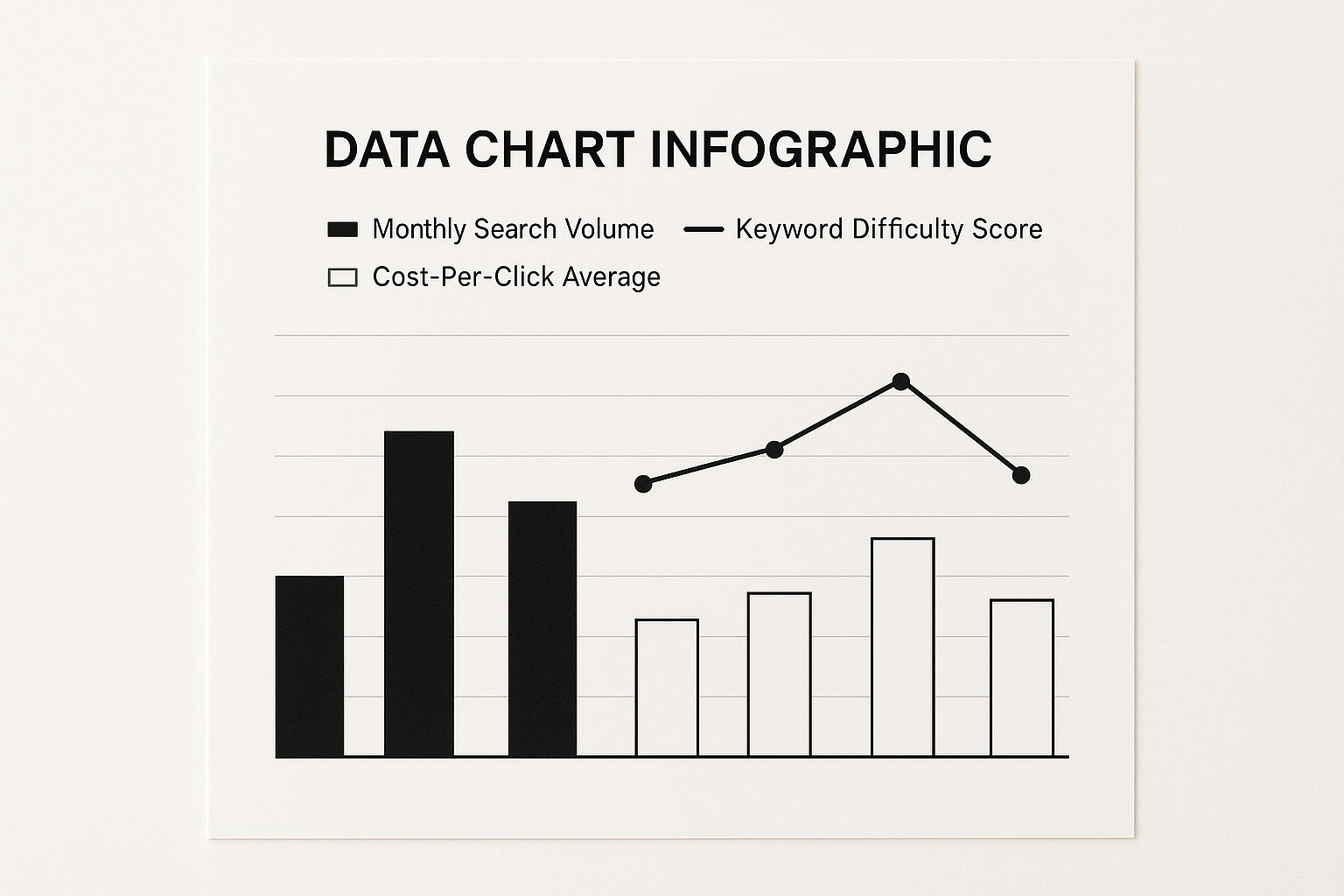how to choose best keywords for seo, keyword research guide, seo keywords, keyword strategy, long-tail keywords
How to Choose Best Keywords for SEO: Tips & Strategies
Written by LLMrefs Team • Last updated August 23, 2025
Before you even think about opening a keyword tool, we need to talk about goals. The secret to effective SEO isn't just about finding keywords with high search volume; it's about finding the right keywords that directly support what you're trying to achieve as a business.
If your goal is to get more product demos, chasing a keyword that only brings in window shoppers is a waste of time. This first step—connecting your keyword strategy to real, tangible business objectives—is the foundation for everything that follows. It ensures every piece of content you create has a clear purpose and a direct path to growing your bottom line.
Aligning Your Keywords with Business Goals

Seriously, before you dive into any tools, take a moment to define what success actually looks like. A great keyword strategy isn’t about pulling in just anyone; it's about attracting the right people who are likely to take a specific, valuable action on your site.
This all starts by translating your big-picture business goals into specific SEO outcomes you can actually measure. Without this crucial link, you could spend months ranking for terms that look great in a traffic report but do absolutely nothing for your revenue.
From Business Objectives to Keyword Intent
So, what are you really trying to accomplish? Are you looking to generate more leads? Drive direct sales through your e-commerce store? Or maybe you just want to establish your brand as the go-to expert in your niche.
Each of these goals maps directly to a different kind of user search intent, which then points you toward the right types of keywords.
Here’s a simple way to think about how different business goals translate into the kinds of keywords you should be targeting. It all comes down to understanding what the searcher is trying to do.
Connecting Business Goals to Keyword Intent
| Business Goal | Target Audience Action | Primary Search Intent | Practical Keyword Example |
|---|---|---|---|
| Increase Product Demos | User is comparing solutions | Commercial Investigation | "best project management software for agencies" |
| Drive E-commerce Sales | User is ready to buy now | Transactional | "buy size 10 nike running shoes" |
| Build Brand Awareness | User is looking for information | Informational | "how to tie a tie" |
| Generate Qualified Leads | User needs a specific service | Commercial Investigation | "roof repair service dallas tx" |
This table helps illustrate the direct line from what you want to achieve as a business to what your potential customer is typing into Google.
I once worked with a SaaS client who was targeting a super broad, high-volume term: "project management." They were getting tons of traffic, which looked great on paper, but their demo requests were flatlining.
We completely shifted their focus to target people who were aware they had a problem. We started going after phrases like "how to manage creative team workflow," which was a specific pain point their software solved perfectly. This one change cut their lead acquisition cost by a whopping 40% because every visitor was infinitely more qualified.
Creating a Practical Customer Persona
Understanding your ideal customer is about more than just knowing their age and location. For SEO, a truly useful persona dives deep into the psychology behind why and how they search. You have to get inside their head to understand their pain points, what they already know (and what they don't), and the exact words they use to talk about their problems.
A classic mistake is assuming your customers use the same industry jargon you do. For example, a software company might use the term "ingest data," but their customers are searching for "how to import contacts into CRM." Your research needs to uncover the natural, everyday language they use when they turn to Google for help.
The best way to build this persona is to get out of your own head and talk to actual people.
- Interview your sales team: What questions do they hear over and over? Ask for the exact phrasing customers use.
- Survey your best customers: Why did they choose you? What problem were they trying to solve before they found you?
- Read through support tickets: What are the most common frustrations and sticking points? Look for recurring issues.
These conversations are an absolute goldmine for finding high-intent keywords your competitors are completely ignoring.
For example, your sales reps might mention that prospects constantly ask if your product integrates with another specific software. That's your cue! It could lead you to target a long-tail keyword like "CRM that integrates with [software name]," which captures someone with a very specific, purchase-ready need. This is how you create content that truly resonates.
It’s also worth remembering just how powerful brand recognition is. Branded keywords make up over 44% of all searches, which shows how building brand awareness can feed your entire keyword strategy down the line.
Finding High-Potential Keywords That Others Miss

Alright, with your business goals locked in, it's time for the discovery phase. This is where we move past just plugging a few obvious terms into a tool. We're going to build a powerhouse list of keywords your competition probably hasn't even thought of yet.
Right now, the goal isn't to find the perfect keyword. It's about casting a wide net and gathering as many promising ideas as possible. We'll look at how to ethically spy on your competition and dive into the online communities where your audience is already talking about their problems.
Reverse-Engineer Your Competitors’ Success
Why start from scratch when your competitors have already done some of the heavy lifting? By digging into the keywords that already send traffic their way, you can uncover proven opportunities and spot the gaps in their strategy.
This is more than just a quick glance at their top-ranking pages. You're looking for patterns, successful content types, and the specific phrases they've managed to own. A good keyword research tool will give you the essential metrics—search volume and competition scores—that turn this from guesswork into a data-driven mission.
Actionable Step:
- Identify 3-5 of your direct competitors (those who rank for terms you want to rank for).
- Use a tool's keyword gap analysis feature. Enter your domain and your competitors' domains.
- The tool will generate a list of keywords they rank for that you don't. Export this list to a spreadsheet.
This process gives you a pre-vetted list of keywords that are already driving business in your niche. If you want a deeper dive into this tactic, our guide on how to perform a keyword gap analysis is a great resource.
Imagine you find a competitor ranking for "how to track sales leads in a spreadsheet." That's a golden long-tail keyword. It tells you the searcher has a specific problem your CRM software can solve, making it infinitely more valuable than a broad term like "CRM software."
Pro Tip: Some of the best opportunities are hiding on page two or three of Google. These are keywords your competitors are targeting but haven't fully optimized for. This is your opening to swoop in with better content and steal the ranking.
Tap into Unconventional Keyword Sources
While SEO tools are indispensable, some of the most potent keywords don't come from a database. They come from real people having real conversations. These online hangouts are goldmines for understanding the exact language your audience uses to talk about their pain points.
Actionable Step:
- Reddit: Go to a relevant subreddit like r/smallbusiness. In the search bar, type a broad topic like "marketing" and look at the post titles. You'll find gems like, "What's the best free way to get local customers?" – a perfect keyword.
- Quora: Search for a topic connected to your business, like "email marketing." Filter by questions. You'll see things like, "How do I build an email list from scratch?" which is a ready-made keyword begging for a piece of content.
- Industry Forums: If you sell specialized photography gear, search "photography forums." On a site like DPReview, you'll find highly technical, long-tail keywords that mainstream tools often miss.
This approach ensures you're targeting keywords based on human language, not just what a machine spits out.
Analyze Google’s Own Suggestions
Google itself is one of the best keyword research tools out there, and it's completely free. The features built into the search results page are designed to help people find what they're looking for, which means they're a direct reflection of real search behavior.
Actionable Step:
- Type a broad keyword, like "content marketing strategy," into Google.
- Scroll down to the "People Also Ask" (PAA) box. Note down the questions shown, like "What are the 5 components of a content strategy?" and "What does a 90-day content plan look like?"
- Continue typing your keyword and observe the Autocomplete suggestions. For "content marketing strategy," it might suggest "for b2b" or "template."
- Finally, scroll to the bottom of the page to the "Related searches" section. Add these phrases to your list.
Each of these is a distinct topic you can build a piece of content around, capturing searchers with very specific questions.
Decoding Keyword Metrics for Smarter Choices
A massive list of potential keywords is just raw data—it's not a strategy. The real magic happens when you start digging into the metrics behind each term to figure out where your best opportunities lie. This is how you move from guessing to making data-informed decisions that actually drive results.
Turning that spreadsheet into an actionable plan means getting comfortable with a few core metrics. Let's break down what Search Volume, Keyword Difficulty, and Cost Per Click (CPC) really mean for your business and how to find the right balance between them.
Here’s a look at the key metrics you'll be juggling as you pick your targets.

Think of it as a balancing act. You need to weigh the potential traffic (volume) against the effort required (difficulty) and the commercial value (CPC) to find those sweet-spot keywords.
Understanding Search Volume
Search Volume is the metric everyone looks at first. It tells you, on average, how many people search for a specific keyword each month. It’s incredibly easy to get mesmerized by the big numbers, thinking that ranking for a term with 50,000 monthly searches is the ultimate prize.
But high search volume is often a trap. These broad "head terms" almost always come with crushing competition from industry giants who have been around for years. Chasing them before your site has built up any real authority is a surefire way to spin your wheels.
Actionable Insight: Instead of chasing "coffee" (volume: 1.5M), a new online coffee store should target "low acid dark roast coffee beans" (volume: 1,900). The audience is smaller but infinitely more specific and qualified.
Gauging Keyword Difficulty
For any new or growing website, this is arguably the most critical metric. Keyword Difficulty (KD)—sometimes called "SEO Difficulty"—is a score (usually from 0-100) that estimates how hard it will be to crack the first page of Google for a specific term.
The score is typically calculated by looking at the quality and number of backlinks pointing to the pages that are already ranking. A high score means you're up against heavyweights with powerful backlink profiles.
The single biggest mistake I see people make is ignoring KD completely. They get tunnel vision on search volume and end up targeting keywords they have zero chance of ranking for. Prioritizing lower KD terms lets you score early wins, build momentum, and start driving targeted traffic much, much faster.
Actionable Insight: If you're a new blog, use your keyword tool to filter for keywords with a KD score under 30. This creates a realistic list of targets you can actually rank for in the next 3-6 months.
The role of AI in search is also changing how this works, making niche authority more important than ever. You can learn more about this shift in our guide to AI search engine optimization.
Interpreting Cost Per Click (CPC)
Cost Per Click (CPC) is a metric pulled directly from the world of Google Ads. It shows how much advertisers are willing to pay for a single click from an ad targeting that keyword. While it's a paid search metric, it's a fantastic clue about a keyword's commercial value for SEO.
A high CPC is a dead giveaway that the keyword drives traffic that converts. If businesses are willing to bid $15 for one click, you can bet that click is making them money. This tells you the searcher is probably in a buying mood.
- Low CPC (e.g., $0.50): Often signals informational intent. "what is a Roth IRA" will have a low CPC.
- High CPC (e.g., $25.00): Strongly suggests commercial or transactional intent. "best robo advisor for Roth IRA" will have a high CPC because searchers are ready to invest.
Actionable Insight: When prioritizing keywords, use high CPC as a tie-breaker. If two keywords have similar volume and difficulty, choose the one with the higher CPC as it likely has stronger commercial intent.
A Practical Keyword Comparison
To show how this all comes together in the real world, let's walk through a side-by-side analysis. Imagine you run an online store that sells high-end running shoes.
Keyword Metric Comparison for Strategic Selection
Here's how you might evaluate two potential keywords to see which one is the smarter bet.
| Metric | Keyword A 'best running shoes' | Keyword B 'supportive running shoes for flat feet' | Analysis & Recommendation |
|---|---|---|---|
| Search Volume | 60,500/month | 1,900/month | Keyword A has massive volume, but Keyword B is still very significant and indicates a specific audience. |
| Keyword Difficulty | 78 (Very Hard) | 29 (Possible) | A new site has almost no chance of ranking for A. Keyword B is an achievable target you can rank for within months, not years. |
| CPC | $3.10 | $2.80 | Both have solid commercial value. The similar CPC tells us that traffic from both keywords is likely to convert. |
| Search Intent | Broad research | Specific problem, solution-aware | Keyword B attracts a highly qualified buyer who knows their problem and is actively looking for a product to solve it. |
The Verdict: While the allure of "best running shoes" is strong, "supportive running shoes for flat feet" is the clear strategic winner. It hits the sweet spot: a healthy search volume, manageable competition, and sky-high commercial intent. This is the kind of keyword that builds a business, one targeted visitor at a time.
Mapping Keywords to Your Content Plan

So you've done the hard work and now have a solid list of keywords. Great. But a list is just raw material—now it's time to turn that data into a real, actionable content roadmap. This is where keyword mapping comes in.
It’s all about strategically assigning a primary keyword and a few related secondary terms to specific pages on your website. Without a map, you end up creating content that accidentally competes with itself or just doesn't connect with what your audience is actually looking for.
By thoughtfully assigning keywords, you give every single page a clear purpose. This creates a cohesive site structure that makes sense to both your visitors and the search engines you're trying to impress. This step is what turns your research on how to choose best keywords for seo into a concrete publishing schedule.
Matching Intent to Page Type
The most fundamental part of keyword mapping is incredibly simple but powerful: match the keyword's intent to the right type of page. When you get this right, you create a smooth journey for the visitor, guiding them from their Google search right to the solution they need on your site.
Actionable Step: Create a simple spreadsheet with two columns: "Keyword" and "Page Type."
- For keywords with commercial intent like "buy running shoes" or "CRM software demo," assign them to your core service or product pages.
- For keywords with informational intent like "how to improve running form" or "what is a sales funnel," assign them to blog posts or guides.
This simple exercise prevents you from awkwardly jamming a sales pitch into a helpful guide, a classic mistake that can drive readers away and muddy the waters for search engines. If you need help turning your strategy into high-quality articles, specialized SEO blog content services can bridge that gap.
Building Topic Clusters to Avoid Cannibalization
One of the most frustrating (and common) SEO missteps is keyword cannibalization. This is what happens when multiple pages on your site are optimized for the same keyword, essentially forcing them to fight each other for rankings. It's like sending two of your own runners to the same race—they just split your chances of winning.
The best way to prevent this is by building topic clusters. This strategy involves creating one central "pillar page" on a broad topic and surrounding it with "cluster pages" that dive deeper into more specific, related subtopics.
A topic cluster strategy does more than just organize your content; it signals to Google that you have deep, authoritative knowledge on a subject. By interlinking the pillar and cluster pages, you build a powerful web of content that lifts the authority of every page involved.
Let's walk through a real-world example. Imagine you run an e-commerce store selling sustainable home goods.
Pillar Page Example
Your pillar page is the main hub, targeting a broad, high-volume keyword.
| Page Type | Primary Keyword | Description |
|---|---|---|
| Pillar Page | sustainable kitchen products | A comprehensive guide covering everything from reusable food storage to eco-friendly cleaning supplies. This page links out to all the cluster pages. |
From this central hub, you'll build out more focused pieces of content that go after more specific, long-tail keywords.
Cluster Content Example
- Blog Post: "best beeswax wraps for food storage"
- Product Category Page: "bamboo dish brushes"
- How-To Guide: "how to make your own non-toxic kitchen cleaner"
- Comparison Post: "silicone vs glass food containers"
Each of these cluster pages targets a unique keyword and, crucially, links back to the main "sustainable kitchen products" pillar page. This approach gives your content a logical structure, sidesteps cannibalization, and helps establish your site as the go-to resource in your niche—a key outcome when you learn how to choose best keywords for seo. You're no longer just targeting keywords; you're building a content architecture.
Targeting High-Intent Long-Tail Keywords
https://www.youtube.com/embed/dE2kDNV0eTc
Everyone seems to be chasing the high-volume, "vanity" keywords. But I've found that the real power in SEO often lies in the specifics. We're talking about long-tail keywords—those longer, more conversational phrases that tell you exactly what a user is looking for.
These are the queries from people who are deep into their research and much closer to making a decision.
Think about it this way. Someone searching for "shoes" is just browsing. But someone searching for "supportive running shoes for flat feet in a size 10" is practically standing at the checkout counter. These super-specific phrases might not get thousands of searches, but they convert like crazy. This is how you find an edge in a crowded market.
For a great breakdown of the fundamentals, check out this guide on understanding long-tail keywords.
Uncovering the Questions Your Audience Is Asking
The most effective long-tail keywords are almost always phrased as questions. Your mission is to figure out the exact questions your ideal customers are typing into Google. Thankfully, Google itself leaves a trail of breadcrumbs for you to follow.
The "People Also Ask" (PAA) box is an absolute goldmine. Search for a broad topic like "project management software," and you'll immediately see questions like:
- What is the easiest project management tool to use?
- How do I choose project management software for a small team?
- Is there a free version of Asana?
Every single one of these is a high-intent, long-tail keyword you can build content around. They represent real, tangible problems people are trying to solve right now.
Actionable Insight: Use a free tool like answerthepublic.com. Enter a broad term like "keto diet," and it will visualize hundreds of questions people are searching for, such as "can you eat fruit on a keto diet?" or "how much protein should I eat on keto?" Each one is a perfect topic for a long-tail keyword-focused article.
The Power of Niche Specificity
Shifting your focus from a generic term to a specific, long-tail keyword is a strategic move that brings in a much more qualified visitor. This is where you can stop shouting into the void and start speaking directly to your ideal customer’s unique situation.
Don't let low search volume scare you off. A keyword with only 50 monthly searches can be infinitely more valuable than one with 5,000 if those 50 people are the exact buyers you need to reach. Relevance is what drives conversions, not just raw traffic.
Here’s what this strategic shift looks like in the real world:
| General "Head" Keyword | Specific Long-Tail Alternative | Who It Attracts |
|---|---|---|
| Project management software | Gantt chart software for construction projects | A project manager in a specific industry with a clear need. |
| Vegan recipes | High-protein vegan meal prep for weight loss | A health-conscious individual with specific dietary and fitness goals. |
| Digital cameras | Best mirrorless camera for travel vlogging under $1000 | A content creator with a defined use case and budget. |
Getting this level of detail right is precisely how to choose best keywords for seo. It directly impacts your ability to attract people who are ready to take action. Focusing on these niche terms is a proven method to increase organic search traffic without having to go head-to-head with industry giants.
Common Questions About Choosing SEO Keywords
Even with a great process mapped out, you’re bound to run into some specific questions once you start getting your hands dirty with keyword research. Let's tackle some of the most common hurdles I see people face.
Getting these details right is a huge part of learning how to choose best keywords for seo. It's what separates a strategy that looks good on paper from one that actually works.
How Do I Choose Keywords If My Website Is New?
When your website is brand new and has little to no authority, you have to play smart. Going after the big, competitive keywords right out of the gate is a surefire way to get nowhere fast. The secret? Low-competition, long-tail keywords.
These are the highly specific phrases that the big players often ignore, but they can bring in traffic that's ready to convert.
- Avoid: A monster term like "digital marketing" (think KD 85). You'll be buried.
- Target: A specific, focused phrase like "social media marketing for local restaurants" (a much more manageable KD 15).
Actionable Insight: Focus your first three months of content creation exclusively on keywords with a Keyword Difficulty score below 20. This allows you to build topical authority and gain initial traction before targeting more competitive terms.
Building a site's authority is a marathon, not a sprint. Focus on winning the small, achievable battles first. Those early successes build the momentum you need for the bigger campaigns later on.
How Many Keywords Should I Target Per Page?
I see this mistake all the time: trying to cram a dozen different keywords onto a single page. That old-school "keyword stuffing" tactic just doesn't work anymore. It muddies the waters for both your readers and the search engines. A much better approach is to give each piece of content a tight, thematic focus.
As a rule of thumb, aim for one primary keyword and maybe two to four secondary, closely related keywords for each page.
Here’s how that looks in practice:
Imagine you’re writing a blog post for an online pet store.
- Primary Keyword:
best dog food for sensitive stomachs - Secondary Keywords:
hypoallergenic dog food brands,limited ingredient dog food,grain-free dog food reviews
See how they all support the main topic? This creates a genuinely helpful, comprehensive resource. You’re not just answering the main question; you're also covering all the related subtopics. This sends a powerful signal to Google that your page is an authority on the subject.
If you're just starting to wrap your head around organic search, it might be helpful to review the fundamentals in this guide on What Is Search Engine Optimization: A Beginner's Guide.
How Often Should I Update My Keyword Research?
Keyword research isn't a "set it and forget it" task. Search trends change, new competitors pop up, and your own business goals will shift. If you're not revisiting your keyword strategy, you're likely targeting outdated terms and missing out on new opportunities.
I recommend doing a full-blown review of your keyword strategy at least once or twice a year. If you're in a really fast-paced industry, you might even want to do a check-in every quarter. A regular audit keeps your content fresh, competitive, and pulling in the right kind of traffic.
Actionable Insight: Set a recurring calendar reminder for every six months titled "Keyword Strategy Review." During this review, use Google Search Console to identify pages with declining traffic and perform fresh keyword research to find new opportunities to update or replace them.
Ready to see how your brand stacks up in the new era of AI search? LLMrefs is the essential tool for tracking your visibility in AI answer engines like ChatGPT, Gemini, and Perplexity. Understand your share of voice, monitor brand citations, and uncover competitor gaps to perfect your Generative Engine Optimization strategy. Start tracking your AI presence today by exploring LLMrefs.
Related Posts

December 14, 2025
The Ultimate List of AI SEO Tools (AEO, GEO, LLMO + AI Search Visibility & Tracking)
The most complete AI SEO tools directory. 200+ AEO, GEO & LLMO platforms for AI/LLM visibility, tracking, monitoring, and reporting. Updated Jan 2026.

December 13, 2025
How ChatGPT memory works, reverse engineered
Reverse engineering ChatGPT Memories reveals it does not use RAG or vector databases. It uses: metadata, facts, conversation summaries, and a sliding window.

December 10, 2025
33 key terms you need to know for AI SEO in 2026
Comprehensive glossary of 33 essential terms for AI SEO in 2026. From GEO and AEO to citations and fan-out queries, learn the vocabulary that defines modern search optimization.

December 8, 2025
AI assistants are not search engines
We analyzed 4.5M ChatGPT conversations. Two thirds have zero commercial intent. People use AI to think, not to shop. Here is what that means for your content strategy.